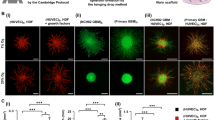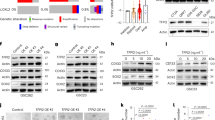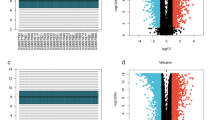Abstract
Glioblastoma (GBM) is the most common and aggressive primary brain cancer; angiogenesis and immunosuppression exacerbate GBM progression. COUP-TFII demonstrates pro-angiogenesis activity; however, its role in glioma progression remains unclear. This study revealed that COUP-TFII promotes angiogenesis in gliomas by inducing transdifferentiation of glioma cells into endothelial-like cells. Mechanistic investigation suggested that COUP-TFII as a transcription factor exerts its function via binding to the promoter of TXNIP. Interestingly, COUP-TFII knockdown attenuated tumorigenesis and tumor progression in an immunocompetent mouse model but promoted tumor progression in an immuno-deficient mouse model. As an explanation, repression of COUP-TFII induces cellular senescence and activates immune surveillance in glioma cells in vitro and in vivo. In addition, we used heparin–polyethyleneimine (HPEI) nanoparticles to deliver COUP-TFII shRNA, which regulated tumor angiogenesis and immunosuppression in an in situ GBM mouse model. This study provides a novel strategy and potential therapeutic targets to treat GBM.
This is a preview of subscription content, access via your institution
Access options
Subscribe to this journal
Receive 12 print issues and online access
269,00 € per year
only 22,42 € per issue
Buy this article
- Purchase on SpringerLink
- Instant access to full article PDF
Prices may be subject to local taxes which are calculated during checkout







Similar content being viewed by others
Data availability
All datasets generated and analyzed during this study are included in this published article and its Supplementary Information files. Additional data are available from the corresponding author upon reasonable request.
References
Tan IL, Wojcinski A, Rallapalli H, Lao Z, Sanghrajka RM, Stephen D, et al. Lateral cerebellum is preferentially sensitive to high sonic hedgehog signaling and medulloblastoma formation. Proc Natl Acad Sci USA. 2018;115:3392–7.
Sun X, Klingbeil O, Lu B, Wu C, Ballon C, Ouyang M, et al. BRD8 maintains glioblastoma by epigenetic reprogramming of the p53 network. Nature. 2023;613:195–202.
Hanahan D, Weinberg RA. Hallmarks of cancer: the next generation. Cell. 2011;144:646–74.
Wang R, Chadalavada K, Wilshire J, Kowalik U, Hovinga KE, Geber A, et al. Glioblastoma stem-like cells give rise to tumour endothelium. Nature. 2010;468:829–U128.
McDonald DM, Baluk P. Imaging of angiogenesis in inflamed airways and tumors: newly formed blood vessels are not alike and may be wildly abnormal: Parker B. Francis lecture. Chest. 2005;128:602s–608s.
Hashizume H, Baluk P, Morikawa S, McLean JW, Thurston G, Roberge S, et al. Openings between defective endothelial cells explain tumor vessel leakiness. Am J Pathol. 2000;156:1363–80.
Lugano R, Ramachandran M, Dimberg A. Tumor angiogenesis: causes, consequences, challenges and opportunities. Cell Mol Life Sci. 2020;77:1745–70.
Al-Ostoot FH, Salah S, Khamees HA, Khanum SA. Tumor angiogenesis: current challenges and therapeutic opportunities. Cancer Treat Res Commun. 2021;28:100422.
Huang MH, Lin YN, Wang CR, Deng LJ, Chen MF, Assaraf YG, et al. New insights into antiangiogenic therapy resistance in cancer: mechanisms and therapeutic aspects. Drug Resist Updat. 2022;64:100849.
Farhood B, Najafi M, Mortezaee K. CD8+ cytotoxic T lymphocytes in cancer immunotherapy: a review. J Cell Physiol. 2019;234:8509–21.
Bagchi S, Yuan R, Engleman EG. Immune checkpoint inhibitors for the treatment of cancer: clinical impact and mechanisms of response and resistance. Annu Rev Pathol Mech Dis. 2021;16:223–49.
Jenkins RW, Barbie DA, Flaherty KT. Mechanisms of resistance to immune checkpoint inhibitors. Br J Cancer. 2018;118:9–16.
Hegde PS, Karanikas V, Evers S. The where, the when, and the how of immune monitoring for cancer immunotherapies in the era of checkpoint inhibition. Clin Cancer Res. 2016;22:1865–74.
Qin J, Tsai SY, Tsai MJ. The critical roles of COUP-TFII in tumor progression and metastasis. Cell Biosci. 2014;4:58.
Xu Z, Yu S, Hsu CH, Eguchi J, Rosen ED. The orphan nuclear receptor chicken ovalbumin upstream promoter-transcription factor II is a critical regulator of adipogenesis. Proc Natl Acad Sci USA. 2008;105:2421–6.
Okamura M, Kudo H, Wakabayashi K, Tanaka T, Nonaka A, Uchida A, et al. COUP-TFII acts downstream of Wnt/β-catenin signal to silence PPARγ gene expression and repress adipogenesis. Proc Natl Acad Sci USA. 2009;106:5819–24.
Xie X, Qin J, Lin SH, Tsai SY, Tsai MJ. Nuclear receptor chicken ovalbumin upstream promoter-transcription factor II (COUP-TFII) modulates mesenchymal cell commitment and differentiation. Proc Natl Acad Sci USA. 2011;108:14843–8.
You LR, Lin FJ, Lee CT, DeMayo FJ, Tsai MJ, Tsai SY. Suppression of Notch signalling by the COUP-TFII transcription factor regulates vein identity. Nature. 2005;435:98–104.
Polvani S, Pepe S, Milani S, Galli A. COUP-TFII in health and disease. Cells. 2020;9:101.
Yun SH, Park JI. COUP-TFII overexpression inhibits cell proliferation and invasion via increased expression of p53 and PTEN and decreased Akt phosphorylation in human colorectal cancer SNU-C4 cells. Anticancer Res. 2020;40:767–77.
Ding W, Zhang Y, Cai H, Liu G, Ye Y, Xu G, et al. Overexpression of COUP‑TFII suppresses proliferation and metastasis of human gastric cancer cells. Mol Med Rep. 2018;17:2393–401.
Qin J, Wu SP, Creighton CJ, Dai F, Xie X, Cheng CM, et al. COUP-TFII inhibits TGF-β-induced growth barrier to promote prostate tumorigenesis. Nature. 2013;493:236–40.
Polvani S, Tarocchi M, Tempesti S, Mello T, Ceni E, Buccoliero F, et al. COUP-TFII in pancreatic adenocarcinoma: clinical implication for patient survival and tumor progression. Int J Cancer. 2014;134:1648–58.
Bao Y, Gu D, Feng W, Sun X, Wang X, Zhang X, et al. COUP-TFII regulates metastasis of colorectal adenocarcinoma cells by modulating Snail1. Br J Cancer. 2014;111:933–43.
Taniguchi H, Suzuki Y, Imai K, Adachi Y. Antitumoral RNA-targeted oligonucleotide therapeutics: the third pillar after small molecule inhibitors and antibodies. Cancer Sci. 2022;113:2952–61.
Gou M, Men K, Zhang J, Li Y, Song J, Luo S, et al. Efficient inhibition of C-26 colon carcinoma by VSVMP gene delivered by biodegradable cationic nanogel derived from polyethyleneimine. ACS Nano. 2010;4:5573–84.
Paunovska K, Loughrey D, Dahlman JE. Drug delivery systems for RNA therapeutics. Nat Rev Genet. 2022;23:265–80.
Zhao J, Ullah I, Gao B, Guo J, Ren XK, Xia S, et al. Agmatine-grafted bioreducible poly(l-lysine) for gene delivery with low cytotoxicity and high efficiency. J Mater Chem B. 2020;8:2418–30.
Yang S, Wong KH, Hua P, He C, Yu H, Shao D, et al. ROS-responsive fluorinated polyethyleneimine vector to co-deliver shMTHFD2 and shGPX4 plasmids induces ferroptosis and apoptosis for cancer therapy. Acta Biomater. 2022;140:492–505.
Chen W, Wang F, Yu X, Qi J, Dong H, Cui B, et al. LncRNA MIR31HG fosters stemness malignant features of non-small cell lung cancer via H3K4me1- and H3K27Ace-mediated GLI2 expression. Oncogene. 2024;43:1328–1340.
You J, Sun L, Wang J, Sun F, Wang W, Wang D, et al. Role of Adiponectin-Notch pathway in cognitive dysfunction associated with depression and in the therapeutic effect of physical exercise. Aging Cell. 2021;20:e13387.
Sun F, Lei Y, You J, Li C, Sun L, Garza J, et al. Adiponectin modulates ventral tegmental area dopamine neuron activity and anxiety-related behavior through AdipoR1. Mol Psychiatry. 2019;24:126–44.
Lal S, Lacroix M, Tofilon P, Fuller GN, Sawaya R, Lang FF. An implantable guide-screw system for brain tumor studies in small animals. J Neurosurg. 2000;92:326–33.
Wang F, Qin K, Wang K, Wang H, Liu Q, Qian M, et al. Nitric oxide improves regeneration and prevents calcification in bio-hybrid vascular grafts via regulation of vascular stem/progenitor cells. Cell Rep. 2022;39:110981.
Hanahan D. Hallmarks of cancer: new dimensions. Cancer Discov. 2022;12:31–46.
Sun X, Cheng L, Duan H, Lu G. Effects of an endothelial cell-conditioned medium on the hematopoietic and endothelial differentiation of embryonic stem cells. Cell Biol Int. 2009;33:1201–5.
Dunn LL, Buckle AM, Cooke JP, Ng MKC. The emerging role of the thioredoxin system in angiogenesis. Arterioscler Thromb Vasc Biol. 2010;30:2089–98.
Schmitt CA, Wang BS, Demaria M. Senescence and cancer – role and therapeutic opportunities. Nat Rev Clin Oncol. 2022;19:619–36.
Milanovic M, Fan DNY, Belenki D, Dabritz JHM, Zhao Z, Yu Y, et al. Senescence-associated reprogramming promotes cancer stemness. Nature. 2018;553:96–100.
Pereira FA, Qiu Y, Zhou G, Tsai MJ, Tsai SY. The orphan nuclear receptor COUP-TFII is required for angiogenesis and heart development. Genes Dev. 1999;13:1037–49.
Qin J, Chen X, Yu-Lee LY, Tsai MJ, Tsai SY. Nuclear receptor COUP-TFII controls pancreatic islet tumor angiogenesis by regulating vascular endothelial growth factor/vascular endothelial growth factor receptor-2 signaling. Cancer Res. 2010;70:8812–21.
Qin J, Chen X, Xie X, Tsai MJ, Tsai SY. COUP-TFII regulates tumor growth and metastasis by modulating tumor angiogenesis. Proc Natl Acad Sci USA. 2010;107:3687–92.
Wang J, Wang XJ, Zhang Y, Shi WJ, Lei ZD, Jiao XY. TXNIP knockout improves cardiac function after myocardial infarction by promoting angiogenesis and reducing cardiomyocyte apoptosis. Cardiovasc Diagn Ther. 2022;12:289–304.
Song MY, Yi F, Xiao H, Yin J, Huang Q, Xia J, et al. Energy restriction induced SIRT6 inhibits microglia activation and promotes angiogenesis in cerebral ischemia via transcriptional inhibition of TXNIP. Cell Death Dis. 2022;13:449.
Duan J, Du C, Shi Y, Liu D, Ma JX. Thioredoxin-interacting protein deficiency ameliorates diabetic retinal angiogenesis. Int J Biochem Cell Biol. 2018;94:61–70.
Hu Q, Li H, Archibong E, Chen Q, Ruan H, Ahn S, et al. Inhibition of post-surgery tumour recurrence via a hydrogel releasing CAR-T cells and anti-PDL1-conjugated platelets. Nat Biomed Eng. 2021;5:1038–47.
He X, Xiao X, Li Q, Jiang Y, Cao Y, Sun R, et al. Anti-CD19 CAR-T as a feasible and safe treatment against central nervous system leukemia after intrathecal chemotherapy in adults with relapsed or refractory B-ALL. Leukemia. 2019;33:2102–4.
O’Rourke DM, Nasrallah MP, Desai A, Melenhorst JJ, Mansfield K, Morrissette JJD, et al. A single dose of peripherally infused EGFRvIII-directed CAR T cells mediates antigen loss and induces adaptive resistance in patients with recurrent glioblastoma. Sci Transl Med. 2017;9:eaaa0984.
Agliardi G, Liuzzi AR, Hotblack A, De Feo D, Núñez N, Stowe CL, et al. Intratumoral IL-12 delivery empowers CAR-T cell immunotherapy in a pre-clinical model of glioblastoma. Nat Commun. 2021;12:444.
Berg JV, Vrohlings M, Haller S, Haimovici A, Kulig P, Sledzinska A, et al. Intratumoral IL-12 combined with CTLA-4 blockade elicits T cell-mediated glioma rejection. J Exp Med. 2013;210:2803–11.
You G, Li W, Wang Y, Cao H, Li X, Gao L, et al. Reduced NR2F2 expression in the host response to infectious bursal disease virus infection suppressed viral replication by enhancing type I interferon expression by targeting SOCS5. J Virol. 2023;97:e0066423.
Smirnov DA, Hou S, Liu X, Claudio E, Siebenlist UK, Ricciardi RP. Coup-TFII is up-regulated in adenovirus type 12 tumorigenic cells and is a repressor of MHC class I transcription. Virology. 2001;284:13–9.
Lin Y, Zhang D, Li Y, Li Y, Li B, Du M. Decidual NR2F2-expressing CD4+ T cells promote TH2 transcriptional program during early pregnancy. Front Immunol. 2021;12:670777.
Kang TW, Yevsa T, Woller N, Hoenicke L, Wuestefeld T, Dauch D, et al. Senescence surveillance of pre-malignant hepatocytes limits liver cancer development. Nature. 2011;479:547–51.
Sturmlechner I, Zhang C, Sine CC, van Deursen EJ, Jeganathan KB, Hamada N, et al. p21 produces a bioactive secretome that places stressed cells under immunosurveillance. Science. 2021;374:eabb3420.
Yi M, Jiao D, Qin S, Chu Q, Wu K, Li A. Synergistic effect of immune checkpoint blockade and anti-angiogenesis in cancer treatment. Mol Cancer. 2019;18:60.
Rahma OE, Hodi FS. The intersection between tumor angiogenesis and immune suppression. Clin Cancer Res. 2019;25:5449–57.
McCrorie P, Vasey CE, Smith SJ, Marlow M, Alexander C, Rahman R. Biomedical engineering approaches to enhance therapeutic delivery for malignant glioma. J Control Release. 2020;328:917–31.
Zhao Z, Shen J, Zhang L, Wang L, Xu H, Han Y, et al. Injectable postoperative enzyme-responsive hydrogels for reversing temozolomide resistance and reducing local recurrence after glioma operation. Biomater Sci. 2020;8:5306–16.
Yu F, Asghar S, Zhang M, Zhang JW, Ping QN, Xiao YY. Local strategies and delivery systems for the treatment of malignant gliomas. J Drug Target. 2019;27:367–78.
Wang L, Cheng CM, Qin J, Xu M, Kao CY, Shi J, et al. Small-molecule inhibitor targeting orphan nuclear receptor COUP-TFII for prostate cancer treatment. Sci Adv. 2020;6:eaaz8031.
Le Guével R, Oger F, Martinez-Jimenez CP, Bizot M, Gheeraert C, Firmin F, et al. Inactivation of the nuclear orphan receptor COUP-TFII by small chemicals. ACS Chem Biol. 2017;12:654–63.
Acknowledgements
This study was supported by the National Natural Science Foundation of China (31900441, 82373097, 82172565, and 32100006; to Jing Du, Jiong Deng, and WD), China Postdoctoral Science Foundation (2023M742089; to FW), Natural Science Foundation of Shandong Province (ZR2019MC026, ZR2023QH080, ZR2022QH192, and ZR2023MH033; to Jing Du, FW, WC, and WF), Funds of Shandong Traditional Chinese Medicine Science and Technology Development Project (2019-0514; to Jing Du), Qilu Outstanding Young Talents in Health Project (to Jing Du), Double-Hundred Project and Taishan Scholarship (WSR2023085; to CAS and Jing Du), Ministry of Education “Chunhui” Plan International Cooperation Project (HZKY20220459; to Jing Du), Research Foundation of Binzhou Medical University Hospital (2022-01; to FW). We would like to thank Editage (www.editage.cn) for English language editing.
Author information
Authors and Affiliations
Contributions
Jing Du and Jiong Deng conceived the original concept and initiated this project. Jing Du and XW designed the experiment and supervised the entire project. FW, FS, BC, BL, and CL established the tumor-bearing mouse models. FW, SZ, and LL carried out in vitro cell experiments. FW, SZ, WD, and CS performed histologic analysis under the supervision of Jing Du. HD and WC did the CHIP-seq. WF, SZ, and WC helped in data collection. Jing Du, CAS, and XW provided critical feedback and helped in review of the article. FW and Jing Du wrote the paper with input from other authors.
Corresponding authors
Ethics declarations
Competing interests
The authors declare no competing interests.
Additional information
Publisher’s note Springer Nature remains neutral with regard to jurisdictional claims in published maps and institutional affiliations.
Supplementary information
Rights and permissions
Springer Nature or its licensor (e.g. a society or other partner) holds exclusive rights to this article under a publishing agreement with the author(s) or other rightsholder(s); author self-archiving of the accepted manuscript version of this article is solely governed by the terms of such publishing agreement and applicable law.
About this article
Cite this article
Wang, F., Zhang, S., Sun, F. et al. Anti-angiogenesis and anti-immunosuppression gene therapy through targeting COUP-TFII in an in situ glioblastoma mouse model. Cancer Gene Ther 31, 1135–1150 (2024). https://doi.org/10.1038/s41417-024-00799-z
Received:
Revised:
Accepted:
Published:
Issue Date:
DOI: https://doi.org/10.1038/s41417-024-00799-z



